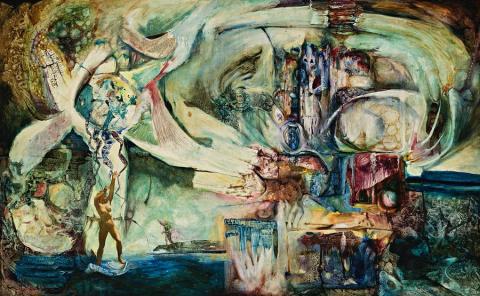BIRTH OF APHRODITE, c.1956
JAMES GLEESON
oil on composition board
76.0 x 122.0 cm
signed lower right: Gieeson
Rudy Komon Gallery, Sydney
Private collection, Sydney
Geoff K. Gray, Sydney, 15 September 1986, lot 166
Private collection, Sydney
James Gleeson, Macquarie Galleries, Sydney, 21 November – 16 December 1956, cat. 13
Tales from ancient Greek and Roman mythology excite the imagination even today, explaining the noble, venial and other lesser ways of the gods and goddesses to us mere mortals. They are, of course, projections of humanity in all its beauty, passion and ugliness. For the Surrealist, these myths provided unrivalled sources for their explorations of the id, those inherited impulses of instinct from the unconscious. Long Australia's leading Surrealist, James Gleeson found them a fertile source throughout his career, the occasions and settings for epic journeys into the subconscious. Paintings in his 1956 exhibition at the Macquarie Galleries, Sydney, included subjects inspired by Prometheus, Odysseus, and Achilles as well as the two paintings on offer.
Aphrodite, or Venus for the Romans, the ravishingly beautiful goddess of love, was another favourite for artists, especially the depiction of her birth. The best loved is Botticelli's Birth of Venus, 1480s in Florence's Uffizi Gallery. Gleeson's Birth of Aphrodite, c1956 presents entirely different interests. While both acknowledge the goddess's birth from the sea, they then parted ways as different as the times during which they were painted. Water has always been one of those mysterious metaphors involving life for Christian and pagan, and the deeper reaches of the psyche. It is often very opaque. In Gleeson's painting the detailed figure of the male nude is replaced by that of the female figure, shell-borne across the sea from which she sprang. The setting is phantasmagoric, the dream world of the subconscious, stretching from the primordial to science fiction. Images advance and recede not according to the laws of perspective, rather those of phantasy and feeling. Gleeson had a brilliantly gifted command of Surrealist techniques, used here for his emotionally complex explorations of that which is woman.
DAVID THOMAS
